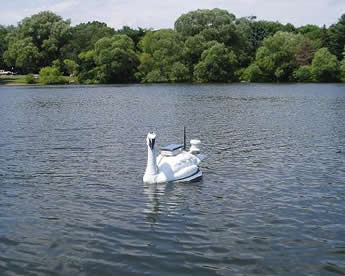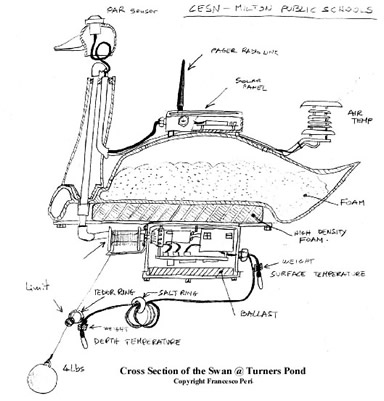Innovative Use of Real-Time Data and Sensor Networks in the Classroom
-- contributed by Kim Frashure

This data-gathering swan decoy, placed in Turner's Pond, Milton MA, contains a modified HOBO 15 channel weather station data logger coupled with a Solar Stream pager telemetry unit. It was designed by Milton Public School students, with help from CESN
COSEE-NE hosted a Ocean Science Education Institute (OSEI) workshop on July 30th & 31st at the University of Massachusetts Boston (UMB) Campus. COSEE-NE Principle Investigator Bob Chen welcomed teachers and science administrators from Boston, Milton and Quincy Public School Districts and The Brookwood School, as well as ocean scientists and facilitators from UMB, Tufts University, and the Blue Hills Observatory. After an introductory activity involving the ocean literacy framework, George (Bernie) Gardner, UMB Physical oceanographer and member of the Center for Coastal Environmental Sensor Networks (CESN), introduced real-time environmental monitoring and its capabilities. During the afternoon and the following day, participant teams focused on developing curriculum based on one of three topics: Marine Biota, Water Quality Monitoring, and Weather/Climate.
The Marine Biota Team was led by UMB facilitator and COSEE program planner Kim Frashure and CESN technical expert Mike Pollard. The team developed three action plans to observe marine biota based upon the work of three scientists. UMB biologist Rob Stevenson will be using input from teachers and students to better predict the timing and population of fish herring runs and the average length of herring through the placement of a real-time camera with a measurement backdrop, to be placed at an existing fish ladder and monitoring station. Scientist Julie Ellis, from Tufts Veterinarian School, helped devise a school project that will aid her research in better understanding the source of deadly parasites among the eider, a sea-bird, through the use of real-time camera monitoring. Students will access the camera images remotely from their classroom to observe and record eider gender, abundance, distribution, and feeding patterns, interactions among other species, and behavior. A third project will assist the graduate work of Shelly Edmundson. Shelly is attempting to better understand water column temperature data in order to identify suitable oyster bed sites off Martha’s Vineyard. Students will collect temperature data via temperature sensors placed on lobster traps at three different depths in the water column. Students will also be able to better understand lobster pot activity through the placement a motion sensor which will record the number of enters and exits. Teachers working on the marine biota team include: Judy Tryon, Marsha Turin, Jim DeMaggio, Lisa Henderson, Lawrence Spezzano, and Paul Muller.
The Water Quality Team, facilitated by UMB’s Bob Chen and technical expert Francesco Peri, focused on two topics, bacterium E. coli and hydrology, which are the research interests of UMB faculty members Mike Shiaris and Ellen Douglas, respectively. This project will also include elements of engineering design technology. Students will assist in the design, fabrication, and deployment of a swan decoy that will house high-tech sensors that will monitor water quality in their local watershed. The decoy’s sensors will measure water data including pH, temperature, dissolved oxygen content, and water flow. The data will be stored in a logger inside the swan decoy and will be transmitted to a website via the use of a pager network. The decoy will be anchored to its site but the design will allow for it to be re-located throughout the watershed, in order to better understand flow and environmental water quality. Barbara Plonski, Science Coordinator, and Mary Murphey, teacher, both of Milton High School, along with Cory Logan of Brookwood School will pilot the high-tech waterfowl this year in their classrooms and in their local watersheds.

The Weather/Climate Team, led by Kristin Mallek, UMB facilitator and Research Associate with the Urban Harbors Institute, developed a lesson plan that will help students better understand how temperature affects their lives and the world around them. With technical assistance from Bernie Gardner of CESN, and weather expertise from Charlie Orloff and John Pickle of the Blue Hill Observatory, the team created a plan that will allow students to use a suite of tools to measure and understand temperature. One of the highlights of the lesson will be having teams of students use Hobo data loggers and software to try to find the locations around their schools that have the greatest temperature range, least temperature range, hottest temperature, coldest temperature, etc. One kit of data loggers will be housed at the Blue Hills Observatory and will be available for loan. Teachers working on the Weather Team include Janice Thomas of the Harbor School, and Kathleen Bertrand and Mary Jill Markarian, both of the Pierce Middle School.
This diverse group of facilitators, scientists and teachers all came together with the common goal of infusing current ocean science into existing curricula. Their action plans now extend well beyond their original goal, as the teams all intend to include experiential learning in the field, field sampling, state-of-the-art research instrumentation, data manipulation, and presentations of research by ocean scientists in the classroom. This will in turn foster a close working relationship among active ocean scientists and educators and will allow for the sharing of resources, materials, and expertise. Teachers will gain knowledge about ocean science and ocean scientists; using ocean science to teach science standards; and developing exemplary ocean science lesson plans. Scientists will learn in depth about curricular frameworks and their impact on student learning; how lesson plans are developed; and about the challenges facing the classroom teacher. Both groups will gain experience in forging productive collaborative partnerships. A follow-up meeting in planned in December to report on progress, and each team is expected to present their OSEI project at a regional or national professional conference.